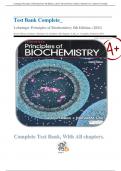Exam (elaborations)
Test Bank Complete_ Lehninger Principles of Biochemistry 8th Edition, (2021) David Nelson (Author), Michael Cox (Author) All Chapters 1-28 | A+ Complete Solutions 2024
- Course
- Institution
- Book
Test Bank Complete_ Lehninger Principles of Biochemistry 8th Edition, (2021) David Nelson (Author), Michael Cox (Author) All Chapters 1-28 | A+ Complete Solutions 2024 Table of Contents Preface viii 4 Chapter 1. The Foundations of Biochemistry 4 I STRUCTURE AND CATALYSIS 30 Chapter 2. Water,...
[Show more]




